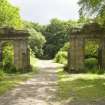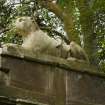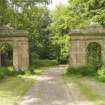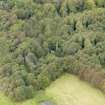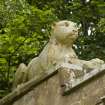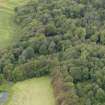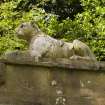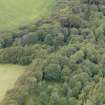Culzean Castle, Swinston Lodge, Cat Gates
Gateway(S) (19th Century)
Site Name Culzean Castle, Swinston Lodge, Cat Gates
Classification Gateway(S) (19th Century)
Alternative Name(s) Culzean Castle Policies; Culzean Country Park
Canmore ID 150620
Site Number NS20NW 40
NGR NS 22895 09234
Datum OSGB36 - NGR
Permalink http://canmore.org.uk/site/150620
- Council South Ayrshire
- Parish Kirkoswald
- Former Region Strathclyde
- Former District Kyle And Carrick
- Former County Ayrshire
NS20NW 40 22895 09234
See also:
NS21SW 1.00 Culzean Castle
The Swinton Gates were designed by Edinburgh architect John Thin c.1800 and topped with recumbant cats made of Coade stone, hence their nickname of the Cat gates.
Photographed in 2009 on behalf of the Buildings of Scotland publications.
RCAHMS (CAJS) 2009.
Ornamental Neo-classical gateway consisting of a pair of triumphal arches flanking carriageway, serving as piers for carriage gates, with pedestrian gates in each archway. Paired pilasters flanking arches and moulded cornices. Entablatures surmounted by plinths supporting pair of recumbent leopards. Polished ashlar construction, sculptures in Coade stone. Iron gates with scalloped upper rails and protruding spearheads. Hooped bracing to uppers and cross bracing below.
The Cat Gates, formerly known as the Swinston gateway, was intended as an extravagant showpiece. Today it is an important as a component of one of the most outstanding and ambitious landscaping schemes undertaken in Scotland. It was erected for the 12th Earl of Cassillis, although the idea of a grand entrance at Swinston, on the route from Maybole, originated with the 10th Earl who had commissioned Thomas White, the landscape gardener, to plan the layout of the grounds in the 1780s. White's designs included the scenic landscape that would have been encountered upon passing through the gates. Most of this landscape has now been obscured by later planting and service roads. The style of the gate must have been a matter of much consideration as there are 4 designs by John Thin, including a castellated one, in the Cassillis archive.
Although designed in 1796, the gateway is unlikely to have been erected before 1809/10, as it was at this time that the 12th Earl achieved a clause in an Act of Parliament for improved Ayrshire roads permitting him to re-route the road from Glenside to Turnberry Park, to pass this point. The impact of the gate itself was severely diminished when the route to Turnberry was diverted by the County in 1817. The gates must therefore have been erected between 1810 and 1816. The scheme, as built, had a pair of lodges but these were demolished in the 1950s.
Together with the remarkable ornamental landscape of its estate, Culzean Castle is acknowledged as the epitome of the Picturesque movement in Scotland, in its own right and is a work of international importance. Culzean, at one time the largest estate in Ayrshire, has been associated with the Kennedy family since the Middle Ages. It was gifted by Gilbert the 4th Earl of Cassillis to his brother Thomas Kennedy, in 1569. In the 1660s, the barmekin around the tower house was breached to create the terraced gardens, orchards, and walled garden for which Culzean was notable, while the caves beneath the castle; now a scheduled monument; were fortified to serve as secure stores.
Culzean Castle became the principal family seat when Sir Thomas Kennedy (1726-75) became the 9th Earl of Cassillis, in 1759. A continuing programme of improvements was undertaken by Sir Thomas and his successors during the 18th and 19th centuries. The 10th Earl began rebuilding the Castle to designs by Robert Adam. This work was continued by Archibald (1770-1846), the 12th Earl, later the 1st Marquess of Ailsa. From about 1810 onwards he commissioned numerous structures, both practical and ornamental, and several important architects and landscape designers were engaged to embellish the gardens and grounds with ponds, gates, lodges and pavilions, resulting in several key works of the Picturesque era. The 3rd Marquess undertook the modernisation and enlargement of the Castle in the 1870s. In 1945, the 5th Marquess of Ailsa divided the property, making over the Castle, and the policies immediately surrounding it, to the National Trust for Scotland. The architect John Thin (c1765-1827), who lived in Edinburgh, is associated with William Sibbald and W H Playfair, for whom he was a draughtsman. He is known to have been involved with an unbuilt scheme of Sibbald's for a church at Falkirk and he produced several designs for gateways, with lodges, for Culzean and Saltoun Hall.
Previously listed as Gate Piers at Swinston Lodge. List description revised as part of the Culzean Castle Estate Review 2010-11. (Historic Scotland).
Field Visit (5 April 2005 - 7 April 2005)
(CUZ17)
Watching Brief (23 October 2014 - 29 January 2015)
Archaeological monitoring works were carried out in respect to various ground breaking works around the grounds and estate of Culzean Castle, Maybole, South Ayrshire. The archaeological works were designed to mitigate the impact on the archaeological remains within their development area. The works carried out did not identify the presence of any significant archaeological features. The only archaeological features present were those relating to modern 19th to 21st century activity.
The programme of works comprised the archaeological monitoring of ground breaking at three areas around Culzean Castle and the Culzean Estate (Figure 1). The three areas were:
1. the garden to the located to the immediate west of the Clock Tower (NGR: NS23352 10306),
2. the Waste Chute (NGR: NS23392 10313) located 10m to the east of the Clock Tower Complex.
3. Hogston Burn Cundie (NGR 2287 0927) which is a culvert under a bend in one of the estate paths, which lies 43m NW of the Swinston or Cat Gates
OASIS ID: rathmell1-202790 (T Rees) 2015
Archaeological Evaluation (6 July 2019 - 12 July 2019)
NS 22904 09244 and NS 22885 09230 As part of a National Trust for Scotland Thistle Camp, volunteers undertook survey and excavation of trenches over the foundations of the two demolished lodge houses on either side of the Cat Gates at Culzean Castle Estate (Canmore ID: 150620). Each of the lodges was about 5.3m long (NW to SE) by 4.6m wide.
Three trenches were excavated over East Swinston Lodge (NS 22904 09244). Trench 1 was positioned over the north corner of the building, Trench 2 over the NE wall and a small lean-to brick extension, and Trench 3 over the SW wall and western corner.
Four trenches were excavated over West Swinston Lodge (NS 22885 09230). Trench 4 was positioned over the NE wall, Trench 5 over the NW wall, Trench 6 over the southern corner and Trench 7 over the SW wall. Trench 4 located the threshold stone for the main door which had a central bolt hole suggesting it was a double door.
Archive: NTS, HER & NRHE (intended)
Funder: The National Trust for Scotland
Derek Alexander and Andy Jepson - The National Trust for Scotland
(Source: DES Vol 20)

















